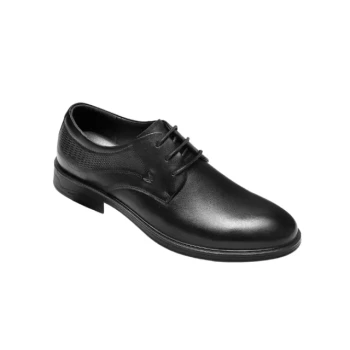The sole of a shoe is its foundational signature. The most immediate and defining difference is material and construction: formal shoes are built upon thin, stitched leather soles with a separate heel, creating a sleek and rigid profile. In contrast, casual shoes utilize thicker, more flexible rubber soles, which are often a single, molded piece, prioritizing comfort and durability.
The distinction between a formal leather sole and a casual rubber sole is not merely about materials. It reflects a fundamental design choice between prioritizing traditional elegance and prioritizing functional, everyday comfort.
The Anatomy of a Formal Sole
A formal sole is engineered for a specific environment and aesthetic. It is designed to complement the sharp, clean lines of tailored clothing like suits and dress trousers.
The Role of Leather
The traditional choice of leather for formal soles is deliberate. Leather is a breathable material that, over time, molds to the wearer's foot, offering a customized fit. Its thinness is key to achieving a discreet, elegant silhouette.
Construction and Profile
Formal soles are characterized by their compact and sleek structure. The sole rarely extends far beyond the shoe's upper, creating a clean edge. They almost always feature a separate heel piece, which adds to the shoe's sharp profile and structure.
The Anatomy of a Casual Sole
A casual sole is built for versatility and the demands of daily life. Its design prioritizes cushioning, grip, and resilience across various surfaces.
The Dominance of Rubber
Rubber and similar synthetic compounds are the standard for casual footwear. These materials provide superior grip, water resistance, and shock absorption compared to traditional leather.
Construction and Profile
Casual soles are visibly thicker and often chunkier. Many, like those on sneakers, are a single molded unit that serves as both the outsole and the visual "midsole." This construction creates a more substantial, grounded, and relaxed appearance.
Understanding the Trade-offs
Neither sole type is inherently superior; they are simply designed for different purposes. Understanding their limitations is key to making the right choice.
The Limits of a Formal Sole
A traditional leather sole offers less traction, especially on wet surfaces, and is more susceptible to wear and tear from abrasive terrain like concrete. It provides minimal cushioning, making it less suitable for long periods of standing or walking.
The Compromise of a Casual Sole
The bulkiness of a rubber sole can appear clumsy when paired with formal attire. Its inherent informality makes it inappropriate for dress codes that require a suit or tuxedo. Furthermore, many casual soles are cemented to the upper, making them difficult or impossible to repair or resole.
Reading the Secondary Clues
The sole's design philosophy is reflected in the rest of the shoe. You can confirm a shoe's formality by observing other details that align with its foundation.
Laces and Eyelets
Formal shoes reinforce their sleekness with thin, round, waxed shoelaces and a small number of eyelets (typically five or six). Casual shoes feature a wide variety of lacing systems, often with larger eyelets and thicker, flat laces.
Overall Structure
The sleek, compact sole of a formal shoe supports an upper with sharp lines and clean edges. The bulkier sole of a casual shoe is paired with a more relaxed, less structured upper, creating an overall appearance of comfort.
Making the Right Choice for Your Context
Your choice should be dictated by the occasion and your primary goal.
- If your primary focus is professional or ceremonial events: Choose a shoe with a thin leather sole and a separate heel to maintain a sleek, traditional silhouette.
- If your primary focus is daily comfort and versatility: Opt for a rubber-soled shoe that provides better cushioning, grip, and durability for various environments.
- If you are ever in doubt about the dress code: A shoe with a more formal construction is the safer choice, as it is generally better to be slightly overdressed than underdressed.
Understanding these foundational differences empowers you to select footwear that is not only appropriate but also perfectly aligned with its intended purpose.
Summary Table:
| Feature | Formal Sole | Casual Sole |
|---|---|---|
| Primary Material | Leather | Rubber/Synthetics |
| Construction | Thin, stitched, separate heel | Thick, often single molded piece |
| Profile | Sleek, rigid, discreet | Chunky, flexible, substantial |
| Primary Focus | Elegance, tradition, silhouette | Comfort, durability, versatility |
| Ideal For | Professional events, suits | Daily wear, varied environments |
Need the perfect sole for your brand or bulk order? As a large-scale manufacturer, 3515 produces a comprehensive range of footwear for distributors, brand owners, and bulk clients. Our production capabilities encompass all types of formal and casual shoes and boots, ensuring the right construction, materials, and style for your target market. Let's discuss your specific needs — contact our experts today for a consultation!
Related Products
- Custom Manufactured Air Cushion Leather Business Shoes for Wholesale
- Wholesale Comfortable Business Casual Shoes Custom Manufacturing
- Wholesale Leather Business Casual Shoes with Dial Closure - Manufacturer of Comfort Dress Sneakers
- Factory Direct Wholesale Leather Comfort Shoes with Dial Closure
- Wholesale Leather Derby Shoes Manufacturer | Customizable Business & Dress Footwear
People Also Ask
- What are the characteristics of business casual sneakers? Master the Polished & Professional Look
- Why are sneakers now accepted in office environments? The Shift to Modern Professionalism
- Are sneakers acceptable in a business casual workplace? How to Choose the Right Style
- Can sneakers be part of a business casual wardrobe? Yes, with the right style and fit
- Are sneakers appropriate for business casual settings? A Guide to Modern Office Footwear



















